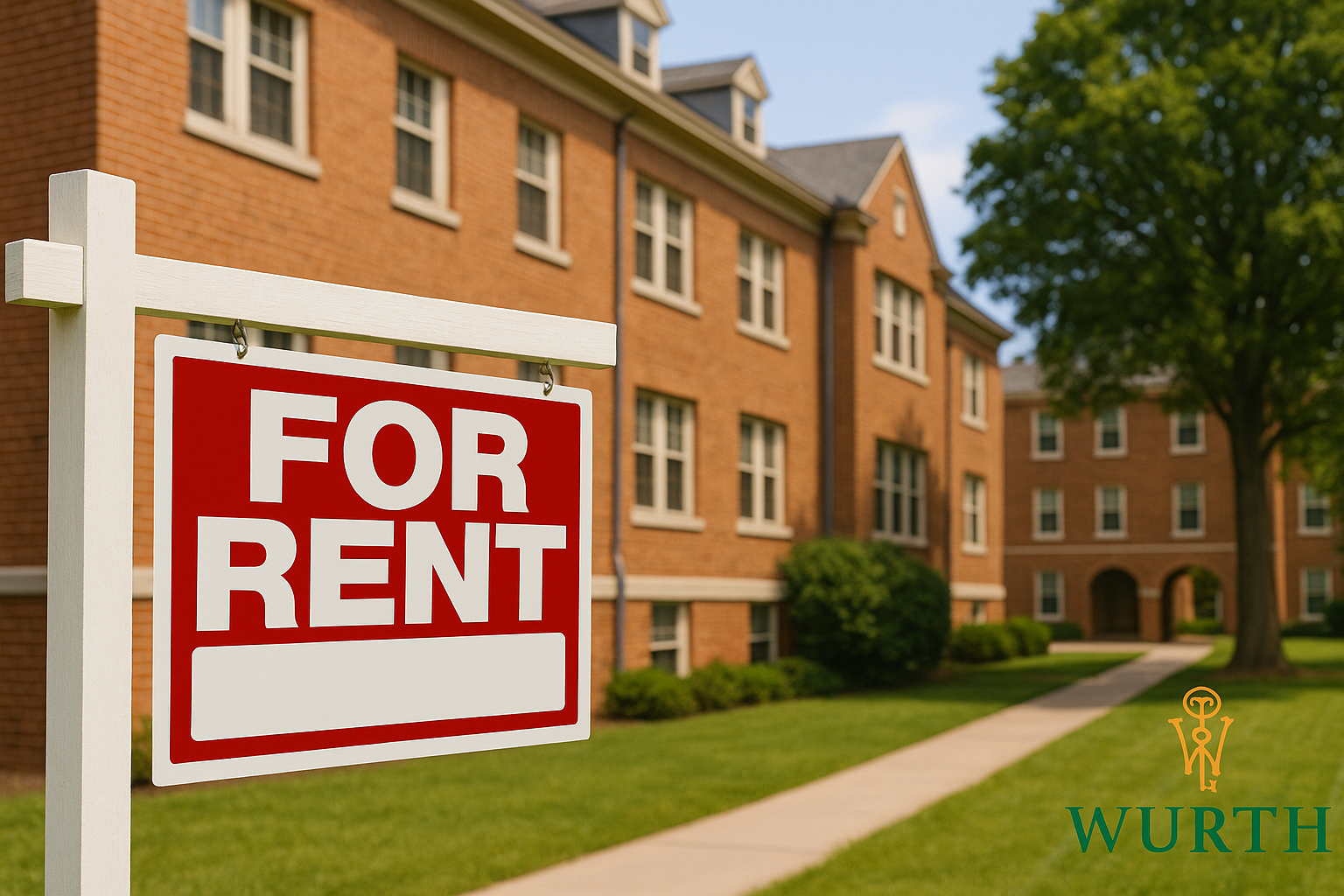There is something strange about college towns. They look perfect on paper.
Steady rental demand. Predictable turnover. Endless groups of students who need housing every single year. It sounds like the easiest real estate play in existence.
Until it isn’t.
Because the college town rental market is one of the rare places where things can be both frustrating and fantastic at the exact same time. The highs are good. The lows are chaotic. Some landlords thrive. Others swear they will never do it again.
Before talking about how to succeed as a landlord in a college town, it helps to understand why these markets can feel like two different worlds depending on what part of the cycle you catch.
Let’s break down the reality.
The Good Part: Endless Demand Wrapped in Predictability
One thing no one can deny. College towns have people. Constantly. Even when enrollment dips, even when the economy sputters, students keep showing up because school is school. And that creates a baseline of demand that rarely disappears.
This is one of the biggest advantages when you look at college town rental market pros and cons. The demand side is easy. You don’t need to convince people to move to your area. They are already coming. Every fall. Every spring. Every semester like clockwork.
That level of predictability makes planning easier. You know roughly when people will rent. You know when they will leave. You know the exact moments your phone will not stop buzzing because the new cohort started hunting for housing six months early.
Some investors love that rhythm.
The Part No One Mentions: The Demand Is Slippery
The downside is that students often want housing at the same time. And they disappear at the same time. Once that window closes, you suddenly have a unit sitting empty longer than you expected.
A lot of small landlords learn this lesson the hard way. They assume the demand is consistent. It is not. It comes in waves.
This becomes even more visible when you compare it to trends discussed in topics like the great tenant shortage conversations happening nationwide. In some regions, adults spread their moves across the year. Students do not. They move in packs. You either catch the pack, or you miss it.
Which makes timing the real skill here.
Student Renters Are Predictable. Their Behavior Is Not.
If you ever want to test the durability of a property, rent it to students. That sounds harsh, but the truth is that young renters tend to live harder in a space than older ones. More foot traffic. More visitors. More energy. More… everything.
This is where investing in rentals near colleges can feel like a gamble. A profitable one, but a gamble. The turnover is fast. The wear and tear is heavier. The maintenance needs stack up quicker.
And when small problems pile up, they become the same type of issue you see in the maintenance backlog situations that ruin ROI. College rentals magnify this even more. One leak left too long becomes three leaks. One messy moveout becomes a full cleanout.
If you’re going to invest here, you need a plan that moves faster than the damage does.
High Turnover: The Double-Edged Sword

Turnover is both the blessing and the curse of college rentals. On the positive side, you can adjust rents more often. You can renovate more often. You can re-screen tenants annually. That flexibility is powerful.
But constant turnover also means:
More cleaning
More repainting
More carpet replacements
More last-minute phone calls in August
More scheduling stress right before classes begin
If you’re trying to calculate the college town rental market pros and cons, turnover belongs in the center of that chart. It is neither good nor bad. It is simply intense. And if you are not ready for that intensity, this market will drain your energy fast.
Parents: The Silent Third Party in Every Lease
One of the more unique quirks in college rentals is the parent factor. You are not just screening students. You are screening families who may never live in the unit but will absolutely be involved in every major conversation.
And while some parents are wonderful, organized, and surprisingly responsible, others unintentionally complicate things. They negotiate differently. They ask questions students never think of. They expect clarity on everything. And they call you when something minor feels major.
If you want to succeed as a landlord in a college town, you learn quickly that communication is as much a skill as maintenance. A confused parent becomes a stressed parent. A stressed parent becomes a parent sending three emails in a row.
Clarity reduces 80 percent of the headaches.
The Amenities Students Actually Notice
No one rents a college unit because it has quartz countertops or a rooftop lounge. Students look for practical things. Space that works for roommates. A decent-sized living area. Proximity to campus. Parking. A washer and dryer that doesn’t eat quarters.
The trend is similar to how remote workers look for functional features rather than flash, as seen in discussions like smart home upgrades that truly add value. Students may not need fancy tech, but they value things that make shared living easier.
Functional wins over attractive in these markets.
The Hidden Risk: University Decisions You Cannot Control
Enrollment shifts. Dorm expansions. Policy changes. New off-campus housing partnerships. These can all reshape a rental market overnight.
If a school builds new dorms, the off-campus market loosens. If the school restricts freshmen from living off campus, demand shrinks. If enrollment grows too slowly, landlords feel it long before statistics catch up.
You are investing in a market where someone else controls the lever. That is part of the risk.
Why Some Investors Thrive Here Anyway
For all the difficulty, college towns can be extremely profitable. They produce consistent demand, short leases, reliable rent cycles, and the ability to raise prices regularly when the market can support it.
The landlords who do well here usually share three habits:
- They screen carefully without assuming every student is irresponsible.
- They maintain the property faster than problems can grow.
- They set clear expectations before move-in.
Property managers often excel in these markets because they already have systems to handle the chaos. They schedule turnover weeks out. They coordinate cleaning in batches. They have templates for student-friendly communication. Their processes carry them through the busiest seasons with fewer surprises.
You can borrow that mindset without hiring a full team. Consistency matters more than experience.
How To Succeed as a Landlord in a College Town
A simple roadmap helps.
- Focus on durable materials.
- Set expectations clearly.
- Price competitively during peak search months.
- Offer leases that match the school calendar.
- Keep repairs fast and predictable.
- And prepare for chaos near graduation week. It happens.
If you treat the rental like a business, not a temporary experiment, you will do well. If you treat it casually, the market will overwhelm you.
If you’re considering a rental near a college and want a team that understands the rhythm of student-heavy markets, we would be glad to help. At Wurth Property Management, we support landlords with systems designed for fast turnover and steady demand. You can reach out anytime.
FAQs
1. What are the main pros and cons of college town rentals?
A: Strong demand and predictable cycles are pros. Fast turnover and heavier wear are common cons.
2. Are rentals near colleges a good investment?
A: Yes, as long as you prepare for maintenance, timing challenges, and seasonal demand waves.
3. How can a landlord succeed in a college rental market?
A: Set clear expectations, maintain the unit proactively, and align leases with the academic calendar.
4. Do student tenants cause more damage?
A: Often yes, simply due to higher usage, more guests, and frequent movement.
5. Should rents be adjusted more often in college towns?
A: Many landlords do, especially with annual turnover cycles giving more pricing flexibility.







